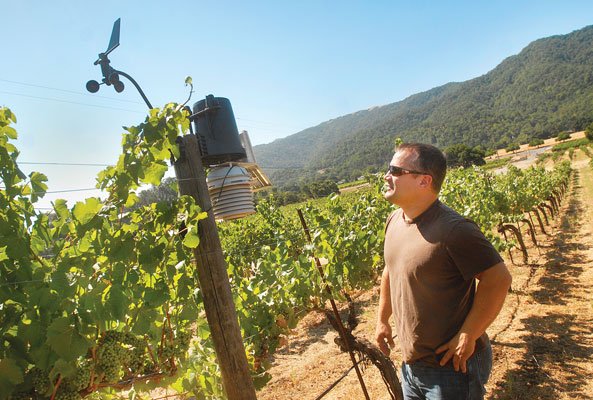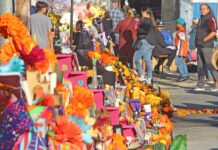Drivers passing by Sarah’s Vineyard along Hecker Pass Highway at
night might notice mysterious blinking blue, red and green lights
among the vines. The colorful rays are not signs of
extraterrestrial life
– they are being emitted by hundreds of solar-powered lamps
attached to grape trellises.
Drivers passing by Sarah’s Vineyard along Hecker Pass Highway at night might notice mysterious blinking blue, red and green lights among the vines. The colorful rays are not signs of extraterrestrial life – they are being emitted by hundreds of solar-powered lamps attached to grape trellises.
“I just like solar. It’s really just for fun,” said Tim Slater, 46, owner of Sarah’s Vineyard. “I went out and bought everything they had at Home Depot, and then I went to Costco.”
Slater, 46, a veteran of the Silicon Valley tech industry with more than 25 patents, also installed state-of-the-art solar-powered monitoring stations to help keep track of moisture, temperature and wind conditions.
Slater became enthralled by solar in his undergraduate days at the University of California, Santa Barbara while studying semiconductor physics. On the side, he took classes on wine.
“Paying attention to the aroma and flavor in a glass of wine leads to the appreciation of food and the arts,” he said. “The next thing I knew, I was going to Le Cordon Bleu in Paris.”
Slater attended cooking school in France several times while devoting his career to high-tech. By 2001, after roughly 20 years of working for startups, he was ready for a change of pace. So he bought the winery, known for its pinot noir and Chardonnay.
“This area is so close, and I had thought it would be a nice retreat. I thought a small winery would run itself,” he said. “It takes over your life.”
When laid off in 2003, Slater considered it a blessing and shifted into making wine his life’s work. He still used his love of technology to refurbish the vineyards and install new winemaking, bottling and laboratory gear.
Slater also installed the monitoring stations, which transmit data to a central web site via a cell phone. The data is obtained from several sensors, including a pressure switch that measures the pressure in the irrigation line – recording when and for how long the grapes are watered – and a probe that is buried underground, monitoring root growth and soil moisture levels.
“This thing is sophisticated enough that you can actually see the grapes at work,” Slater said. “During the day, you’ll see the moisture level dropping. As the grapes shut down, you’ll see the rate of moisture change. You can see it directly. And you can compare the data to past years.”
Information from the stations is compiled and combined with data collected from a weather station located among the vines. The data can be accessed from any computer, including a laptop in the laboratory tucked into the top floor of the winery.
“Our little wine lab is probably better stocked than a 50,000-case winery’s,” said Slater, a self-described “mad scientist.”
On one shelf rest beakers, microscopes and chemistry sets, and on another shelf sits the OenoFoss, a small device that analyzes half-milliliter samples of wine to measure seven parameters – sugar, pH, total acid, glucose and fructose, malic acid, ethanol and color. Slater calls the machine the “crown jewel” of the lab, and because it’s quite expensive, few if any other wineries in the area own one.
“Normally, you’d send a pint of wine to a lab, and they’ll send the information to you in a couple of days,” he said. “It measures all of these things in almost two minutes with an almost negligible amount of wine. We can analyze every single barrel of wine.”
Manager and winemaker Rob Henson could also obtain much of the same data using his elaborate chemistry setup, and it’s clear he does from time to time, since the pages of a chemistry book lay open. But the work the OenoFoss does in two minutes would take Henson 10 minutes the traditional way.
“Without the science, you can make a great wine every once in a while,” Henson said. “(Science) keeps it consistent.”
Henson manages the day-to-day operations of the winery because Slater lives in Seattle, where he chose to reside for its vibrant restaurant scene. Slater works from home and frequently commutes to Gilroy for one-week stints to operate the tasting room and tackle other tasks.
Slater is currently installing his newest piece of gadgetry at the winery: a pizza oven. It merges all three of his loves – wine, technology and food.















